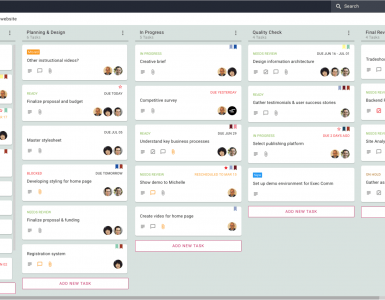A freelance writer resumé can be critical when it comes to promoting your freelance writing business. If you don’t have a clean, easy-to-read, writing resumé already created and ready-to-go, then you might be missing out on your next big freelance writing opportunity.
That’s because while most freelancing marketplaces don’t tend to require a resumé, many quality clients who are hiring freelancers still rely on a freelance writer resumé to identify quality candidates for their projects.
The good news is, creating the perfect freelance writer resumé is extremely straightforward and easy to do. You should be able to knock it out in an afternoon (if you have all the important information you need).
This guide will outline exactly what to include (and what not to bother with) in your freelance writer resumé so you can find more freelance work. We’ve also thrown in some example resumés to give you some extra context.
1. Start with basic information
As with a traditional work resumé, your freelance writer resume should start with some basic information including:
Your full name
This is very straightforward, but you might be wondering whether you should utilize your own personal name or your freelance business name when creating a freelance writer resumé.
In a resumé setting, we suggest putting your own name since this is essentially a job application, not a business proposal (which is completely different).
If you insist on using your freelance business name as well, perhaps you can use some nice hierarchy to highlight your name first and your business secondary. However, keep in mind that each piece of text you put on your freelance writer resumé is real estate you could be using to really sell yourself.
Your contact information
Of course, one of the primary goals of any freelance writer resumé is to get a client to call you and book an interview (or even hire you immediately).
That means your contact information should be front-and-center (not an afterthought) plus large and legible enough to read easily.
Don’t make someone work too hard to contact you. The easier it is, the better chance you have of getting the gig.
The contact information you choose to include on your freelance writer resumé may depend on the situation, but here are a few good options:
- Your phone number
- Your email address
- Your website
- Your Skype/Zoom/Google Hangout ID
That way, clients who like to get on the phone can dial a quick number while those who prefer to schedule a Zoom meeting can choose that route.
Remember, the goal is to make it as easy for your potential client as possible.
A professional headshot
While this last suggestion is definitely controversial, I recommend adding a professional headshot to your freelance writer resumé.
Even though remote and non-traditional workers are becoming much more commonplace, some clients are still hesitant when it comes to hiring a freelancer.
Including a nice headshot will not only make you more personable, it will also add to the confidence rating for some resumé readers.
A smiling face can go a long way to soothe fears about hiring the wrong person for the job.
Other freelance-specific info you may want to include
In addition to these rather expected personal and professional elements, you may want to include a few “freelance-specific” elements to further provide confidence and pre-empt any important questions or hesitations your client might have.
Some of these include:
Time-Zone or Country of Residence
Some clients only want to work with freelancers in their own time-zone or within 1-2 time-zones.
Make it clear which timezone you work in. Even if you live on the other side of the world but work at night, make it clear when your client can expect to have you available “in the office.”
Native & Secondary Languages
If you speak the same language as your potential client, listing that on your freelance writer resumé can help you stand out from the crowd.
This is especially true for freelance writers. Even more important than speaking the same language as your client is a native or fluent understanding of the language you’ll be asked to write in.
Nationality
While it’s not something you might include on a traditional resumé, some companies simply are not allowed to hire freelancers who do not live in certain countries.
If you live in the same country as your client, it’s worth adding that information to your freelance writer resumé.
Availability
Finally, it may be helpful to include information regarding your availability to your potential new client.
Will you offer part-time hours to this client? Full-time hours? Will you be juggling this client with a dozen others? Or will you be dedicated exclusively to their freelance writing jobs?
2. Add ways to learn more about you and your work
Secondly, you may want to include ways your potential clients can review some of your best work.
Once you pass the preliminary scan, many clients will then review some of your work to see if it matches what they are searching for in a freelance writer.
Keep this information to a minimum, offering it as an additional element of your freelance writer resumé that will allow the extra-curious hiring manager to explore your background more fully.
Here are a few ways to highlight your work on your freelance writer resumé:
Link to your portfolio
The most obvious way to show off your writing work is to link to a website portfolio.
Take time to build a website that looks professional and is easy to navigate.
Use this checklist to convert your drab portfolio into a client-converting machine. Then all you have to do is get them from your freelance writer resumé over to your portfolio and you’re all set.
As a word of caution: do NOT simply upload a hundred .pdf files to a website and ask a potential client to download each one to review it. They likely won’t. And even if they do, it’s a terrible user experience.
Instead, look into quality web page builders for non-coders to help you get something that looks professional, works well, and doesn’t frustrate your potential clients. You can also use a portfolio builder such as Pixpa, which will do the hard work for you.
Link to social media feeds featuring your work
If you have some Linkedin articles or an Instagram feed that highlights your best work and favorite client projects, consider including it on your resumé.
These frequently posted snippets and samples of work showcase a body of quality work as well as potentially elaborating on your process as a freelance writer.
Remember, these feeds are like your portfolio: it’s not about “likes,” it’s about conversions.
Link to your own freelance writing blog
If you’re a freelance writer, I’m going to guess you also have your own blog where you write frequently.
Linking to your blog from your resumé is a great way to highlight your abilities as a freelance writer. Make sure your blog stays professional (less personal) so you feel comfortable sending it to potential clients.
3. Feature relevant freelance work
Now we come to the meat of your freelance writer resumé: listing your relevant freelance work.
It can be hard to know how to list freelance work on your resume since it’s less common than the traditional “Job Title, Company Name, Years Worked” format you might see on a resumé for a salary position.
To list work on your freelance writer resumé, we recommend you start with your favorite projects, most notable clients, and best business results.
Favorite projects
Here’s the truth of the matter (and you know this if you’ve been a freelance writer for long):
There are a lot of freelance writers out there.
The other hard truth is there are a lot of very talented freelance writers out there. It’s a tough field to be in.
But if you’re a freelance writer, you’re in it because you love the work you do each day. You have a passion for writing—a love for the written word.
That passion, when shared correctly, will stand out in a stack of copycat freelance writer resumés. For that reason, it’s important to highlight some of your favorite projects on your resumé. As your passion and energy shine through, you’ll be more likely to get the gig.
Notable clients
If you have worked for some notable clients (for example big brand names) then that is worth highlighting on your freelance writer resumé.
Not only does this offer some social proof to your potential client (they think “if this company I’m familiar with trusted this freelance writer, so can I”) it also shows the caliber of work you can deliver.
In addition this workplace form of “name dropping” can also show you know what it takes to deliver at a high professional level.
Lucky for you, “notable” is all relative. If you’ve done freelance writing jobs in a very specific category or niche, big names in that arena will mean something to fellow companies in the same niche—even if most of the world is unfamiliar with them.
Likewise, if you’ve worked for a “big name” in your city, you can highlight that work even though the rest of the country may not be familiar with their brand.
Business results
There’s one critical question that most people ask when hiring a freelance writer:
What can this freelancer deliver to my bottom line?
The better you can answer that question on your freelance writer resumé, the more likely you’ll be to get hired for the freelance jobs you really want.
With that focus, you might see how you would list certain projects and not others.
For example, if you did some freelance writing jobs as a beginner that didn’t really contribute anything notable to your client, you can leave those off.
Instead, include jobs that made a visible impact.
Avoid phrasing your accomplishments in terms of tasks accomplished
eg. “wrote a blog post every week”
and try identifying results achieved
eg. “increased SEO traffic and sales by 28%”
Here are some more critical things to consider when listing your freelance writing work on your resumé:
Don’t lump everything into “one experience”
Because traditional resumés tend to lump in an entire tenure at one company into a few lines, it can be tempting to do the same with your freelance writing business: lumping your full career into a line that reads “Freelance Writer” followed by some vague bullet points like “Wrote blog posts for clients.”
Let me save you the heartache now: if you follow that pattern, your freelance writer resumé is going to struggle miserably.
Don’t worry about listing everything you’ve ever done
Conversely, you shouldn’t worry about listing every single freelance writing job you’ve ever worked on. Instead, focus on the jobs that are most relevant to the gig you’re applying for in the moment.
Of course, this means a templated freelance writer resumé that you never adjust simply won’t cut it. You’ll need a fluid document you can update and change every time you apply for a new freelance job.
Freelance writer resumé examples (good and bad)
To round out this article, let’s take a look at a few great freelance writer resumés (and some with mistakes) to better illustrate what I’ve outlined above:
What he does well: This freelance writer makes his contact information clear and easy to find.
Where he could improve: The “personal statement” is a very long block of text (which we writers are prone to create at times) and likely won’t get read. Instead, he should highlight a few critical pieces of information about what he can deliver for a potential client.
What she does well: This freelance writer includes a professional headshot to make her resumé stand out and makes her contact information very accessible as well.
Where she can improve: Again, the long summary is just…well…long. Keep in mind the person hiring you may not be as much of a word-lover as you are or they wouldn’t need to hire a writer in the first place.
What he does well: This writer does a nice job outlining his native and fluent languages.
Where he could improve: Under professional experience, he has lumped everything together under the headline “Freelance Writer” instead of breaking them out by discipline (script writing, copywriting, etc.) or project (TV show name, social media account name, etc.)
The next step in getting the perfect freelance writer resumé
Now that we’ve covered all of that, here’s the critical next step in making a really great freelance writer resumé:
Just get started.
It won’t be perfect the first time around. But done is often better than perfect.
Over time, you can iterate, make changes, improve, learn, change and adjust where you need to.
Eventually, you’ll find your sweet spot and your freelance writer resumé will start bringing you new freelance jobs like clockwork.











